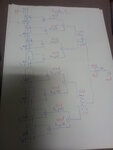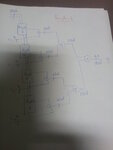azwaa
Member level 1
i have here a programme that calculate the correlation of data bits with 8 bits as length in this case i will need for the calculation 4 stage the figure explain the program , so i want to do it with variable length 16 or n for length so can you help plz
Thank you in advance for your reponse
Thank you in advance for your reponse
Code:
library ieee;
use ieee.std_logic_1164.all;
use ieee.numeric_std.all;
entity correla4bit is
port (
clk : in std_logic ;
rst : in std_logic ;
data: in std_logic_vector(11 downto 0) ;
code: in std_logic_vector(15 downto 0 ) ;
Q :out std_logic_vector(17 downto 0) ) ;
end entity ;
architecture arch of correla4bit is
type RAM is array (0 to 3) of std_logic_vector(3 downto 0) ;
type ram16 is array (0 to 3) of signed(15 downto 0) ;
type Rom is array (0 to 3) of signed(11 downto 0) ;
signal voie :Rom ;
signal CD : RAM;
signal temp: ram16;
signal sum0 :signed (16 downto 0) ;
signal sum1 :signed (16 downto 0) ;
signal AB :signed (17 downto 0) ;
begin
CD(0) <= code(15 downto 12);
CD(1) <= code(11 downto 8);
CD(2) <= code(7 downto 4);
CD(3) <= code(3 downto 0);
etalement:process(clk,rst)
begin
if(rst='1') then
Q <=(others=>'0');
temp(0)<=x"0000";
temp(1)<=x"0000";
temp(2)<=x"0000";
temp(3)<=x"0000";
elsif(clk'event and clk ='1') then
voie(0)<=signed(data) ;
voie(1)<=voie(0);
voie(2)<=voie(1);
voie(3)<=voie(2);
for i in 0 to 3 loop
temp(i) <= voie(i)*signed(CD(i));
end loop ;
sum0<= resize(temp(0),17)+temp(1) ;
sum1<= resize(temp(2),17)+temp(3) ;
AB<=resize(sum0,18)+sum1 ;
Q<=std_logic_vector(AB) ;
end if ;
end process ;
end architecture ;
